
Winter Groove is one of the most attractive places in the center of St. Petersburg.
The Winter Canal is one of the oldest canals in the city. It is a man-made canal that connects the Neva River (Dvortsovaya Embankment) and Moika River (Moika River Embankment) and flows between the 1st and 2nd Admiralty Islands.
The canal was dug in 1718-1719 under the direction of the builder-contractor Vasily Ozerov, and ran near the Winter Palace of Peter I in such a way that the tsar could get into a boat right from the threshold of the house.
The channel got its name "Winter" from its location-near the walls of the Winter Palace of Peter the Great.
During the history, other names of the canal were also in use: Zimnedomskaya (Zimnedvortsovy) or Old Palace; since 1755-Winter, and since the beginning of the 19th century - Winter groove.
In 1783-1784, the walls of the canal, based on wooden ridges filled with stone, were rebuilt. The body of the channel walls consists of rubble masonry with granite blocks facing.
Subsequently, the walls of the canals, together with the bridges that run over them, were strengthened and restored.
The length of the canal is about 228 meters - it is one of the shortest channels in the city; and its width is about 20 meters.
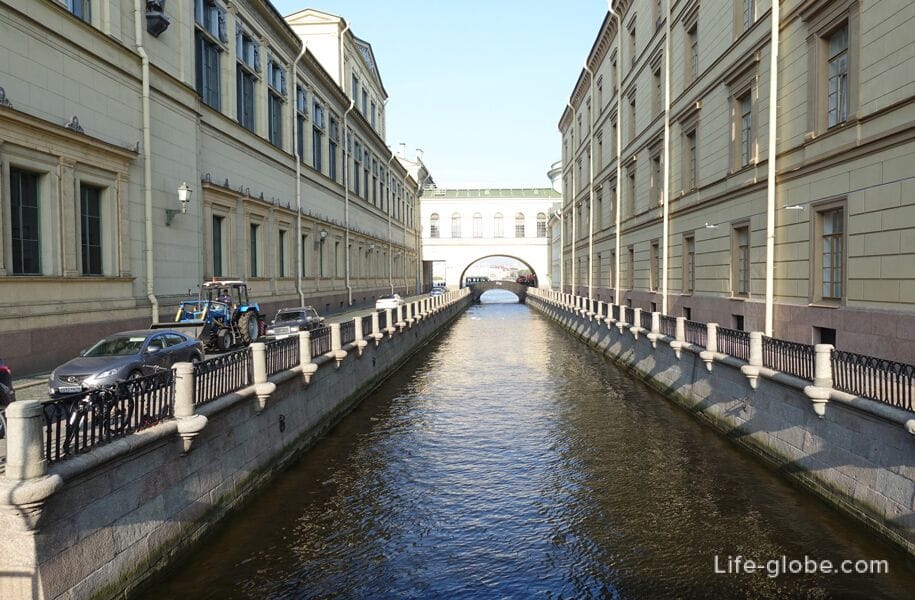

Along the canal, on both sides, runs the embankment of the Winter Canal, which is a roadway and pedestrian road.
At the end of the 18th century, the canal embankment was called the Post Office, because there was a Post Office Yard nearby.
The embankment fence along the canal is a wrought-iron Gothic lattice pattern, installed between hewn round bollards.
Along the embankment of the Winter Canal, historical buildings stand in dense rows, and the canal itself is crossed by three bridges.

Along the axis of the Palace Embankment at the source of the Winter Trench runsHermitage Bridge, which is one of the oldest stone bridges in St. Petersburg.
The first wooden drawbridge on this site was spanned in 1718-1720 by Harman van Boles.
Subsequently, the bridge was rebuilt.
The permanent stone bridge was built in 1763-1766, simultaneously with the construction of the granite embankments of the Neva River, becoming the first stone bridge in the city.
In 1934, the brick-and-tile arch of the bridge was replaced with a reinforced concrete (monolithic boltless) with outrigger heels and an internal outline, while the external appearance of the bridge was preserved.
Today, the Hermitage Bridge is a single-span arched structure with a solid reinforced concrete arch in the form of a hinged arch outlined in an ellipse. The abutments of the bridge are made of rubble masonry on a pile base and faced with granite. The railings are made in the form of solid granite parapets. The sidewalks are lined with granite slabs, the bridge's openers have granite staircases to go to the level of the embankments.
In its external appearance, the Hermitage Bridge is an integral part of the Palace Embankment, which runs along the Neva River. Learn more about the Palace Embankment…
View of the Hermitage Bridge and the Palace Embankment from the Neva River

The Hermitage Bridge became world famous after the release of Tchaikovsky's opera The Queen of Spades in 1887, when the authors introduced an episode into the libretto that was not present in Pushkin's story: in the third act, the heroine of the opera Lisa throws herself into the water of the Winter Ditch from the Hermitage Bridge. After that, in St. Petersburg folklore, the bridge was given the informal name "Lisa's Bridge".
Part of the Winter Groove at the Hermitage Bridge is one of the most beautiful and photographed places in the center of St. Petersburg.
Above the water is a high arch-passageconnecting the building of the Hermitage Theater and the Grand Hermitage.
There is a legend according to which the envious decided to slander the architect of the arch-Quarenghi in the eyes of the Empress Catherine II, and started a rumor that the arch is fragile and can collapse at any time. Catherine, in order to pacify evil tongues, arranged a grand feast with numerous guests in the areca gallery. The arch-the bridge-survived, and all the rumors were dispelled. The veracity of this story is doubtful, as is the fact that the arch was built by Quarenghi, because modern sources say that the arch was built by the architect Yu. M. Felten.
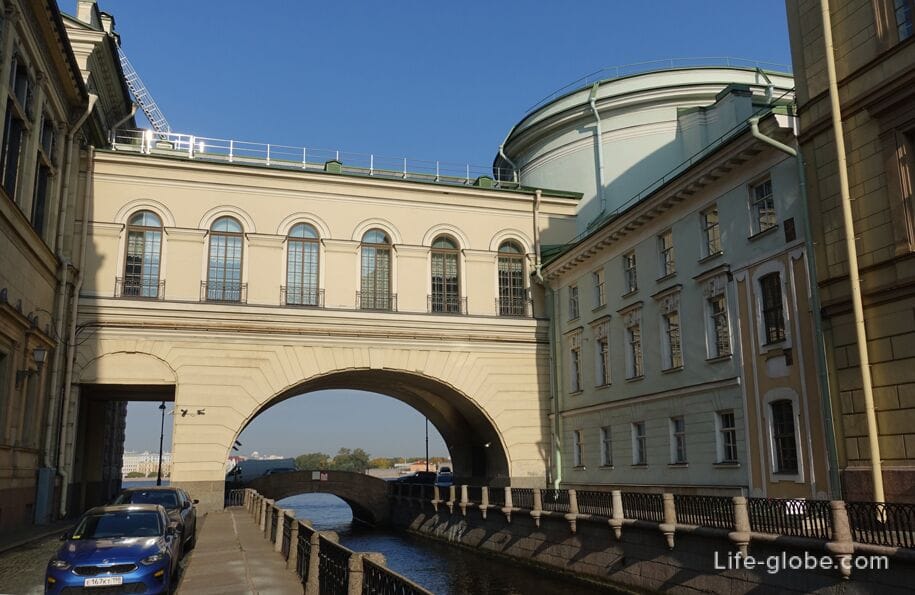
On the eastern side of the trench (near the Hermitage Theater) is the Winter Palace of Peter the Great and the Hermitage Theater, which is a historical and architectural monument.
The Winter Palace of Peter the Great was built in 1712 as the personal residence of Emperor Peter the Great.
At the end of the 18th century, the Hermitage Theater was erected on the site of the palace, and only a small part (rooms) have been preserved from the former palace, which are now included in the Hermitage Theater.
The theater gives performances and concerts, and exhibitions are organized in its lobby. In the preserved part of the Winter Palace of Peter the Great there is a memorial exhibition dedicated to Peter the Great and his era, which is part of the State Hermitage Museum. Read more about the Winter Palace of Peter the Great (The Hermitage Theater)…
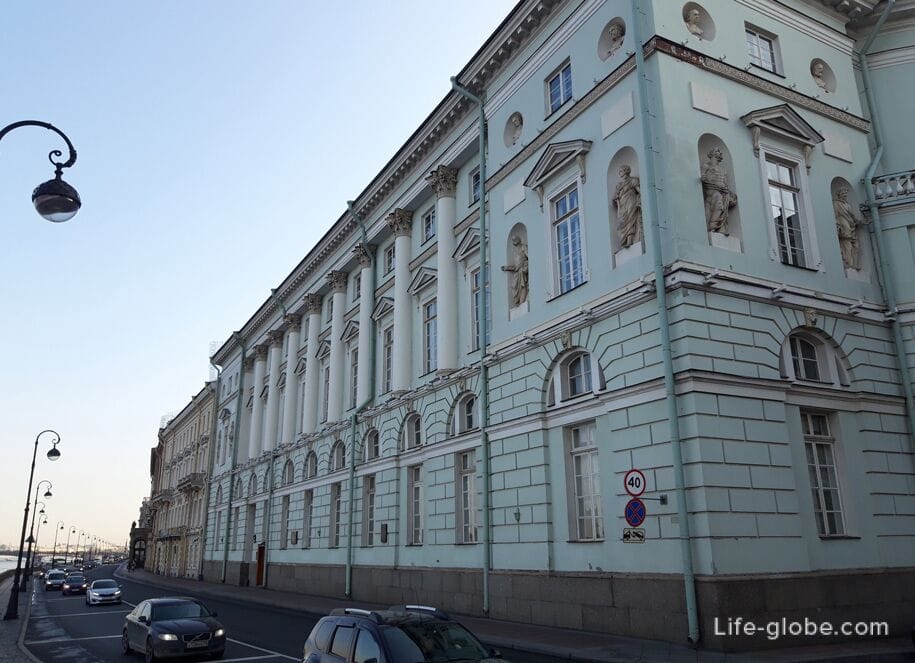
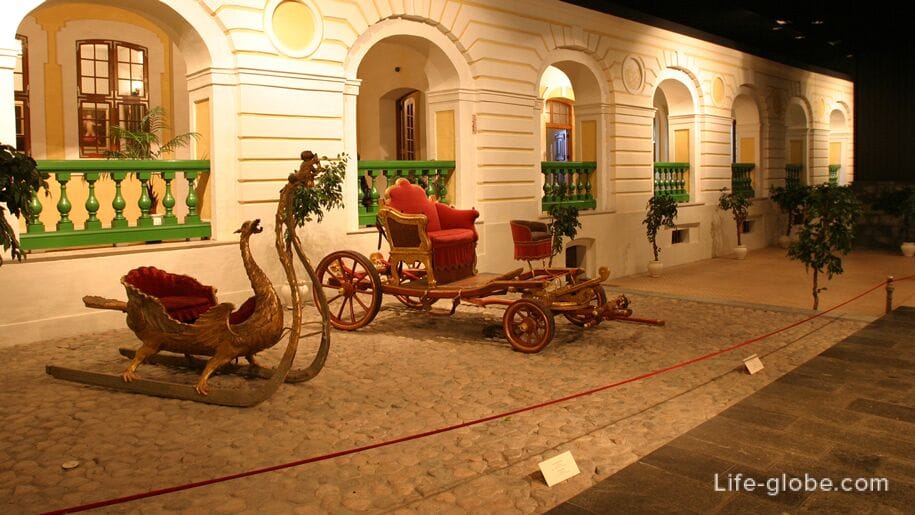
On the west side of the groove (opposite the Hermitage Theater) isThe Grand (old) Hermitage, which was built in 1771-1787 by the architect Yu. M. Felten, commissioned by the Empress Catherine II as a continuation of the palace buildings, to house the palace collections and library.
In 1792, Giacomo Quarenghi added a building to the Grand Hermitage that housed the Raphael Loggias-a close-to-the-original replica of the famous gallery of the Papal Palace in the Vatican.
Within the walls of the Old Hermitage there is an exhibition of the State Hermitage Museum, which presents the art of Renaissance Italy. Read more about the State Hermitage Museum…
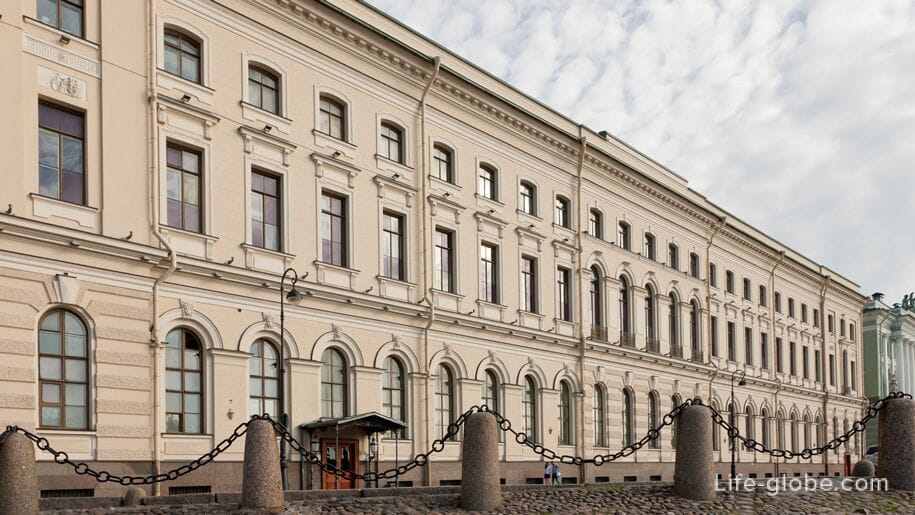
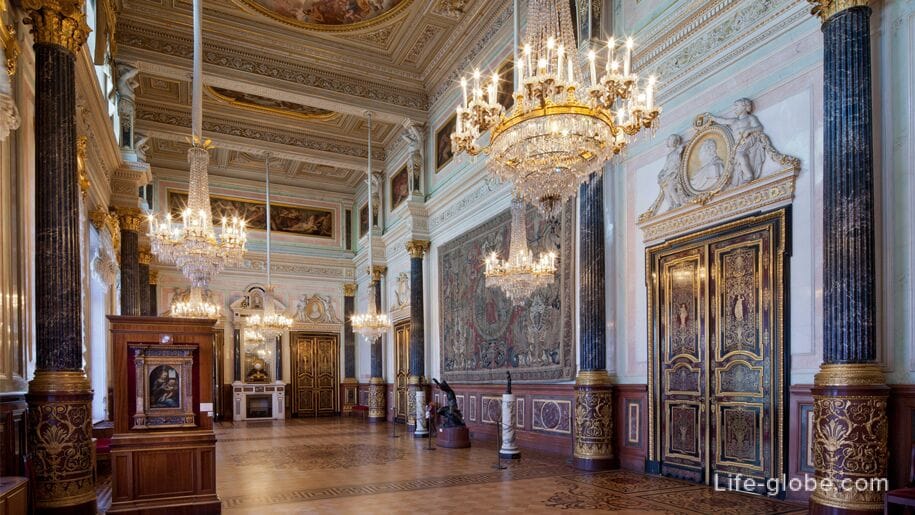
On the side of the Winter Canal and Millionnaya Street, the corner building adjoins the building of the Grand HermitageThe New Hermitage Museum is the first building in Russia created specifically to house the museum's art collections.
The building was built in 1842-1851 by the decree of Emperor Nicholas I in the style of historicism with austerity and monumentality of appearance.
In the architecture of the building, the porch (portico) is particularly attractive, which in front of the main entrance (Millionnaya Street) is decorated with 10 figures of Atlanteans of huge sizes, carved from gray Serdobol granite and mounted on pedestals of rapakivi granite.
In the halls of the museum building, which have preserved their historical appearance, there are collections of ancient art, painting, sculpture and decorative and applied art of Europe. Learn more about the portico and the New Hermitage…


The Winter Bridge, also known as the 1st Winter Bridge, runs through the Winter Groove along the axis of Millionnaya Street, which is a stone single-span arched structure with a length of 19.4 meters and a width of 21.6 meters. The superstructure is a parabolic arch, the facade is faced with granite. The abutments of the bridge are stone on a pile foundation, faced with granite.
The railing of the bridge is a solid granite parapet. From the sidewalk of the bridge, lined with granite slabs, to the embankment of the Winter Groove, there are small descents. On the upper side of the bridge on the embankment there are two stairways to the water of the Winter Trench.
The first wooden drawbridge in this place was spanned in 1718-1720.
Subsequently, the bridge was rebuilt. It acquired its present appearance in 1783-1784, when the nearby Red Canal (now defunct) was filled in, the bridge over which was dismantled in parts, moved and thrown over the Winter Canal.
Initially, the bridge was called German-on the Big German Street, which was so called due to the nearby German settlement; later the street was renamed Millionnaya-the same became the name of the bridge; since 1829-Winter Bridge, on the Winter Groove; and since 1940-the 1st Winter Bridge.
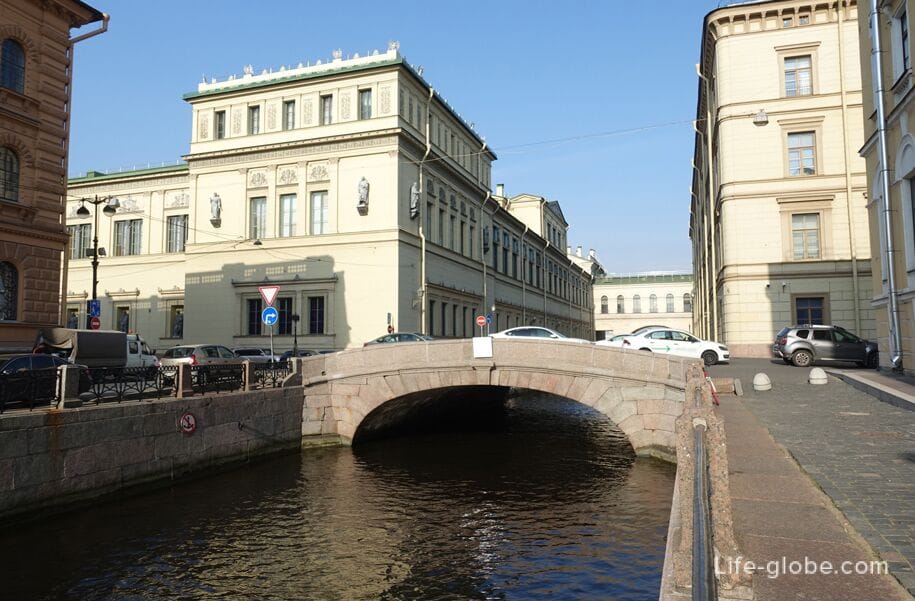
At the corner of Millionnaya Street and the embankment of the Winter Canal (on the southwest side of the Winter Bridge) is the corner building of the Naval Archive, which was built in 1883-1887 for the archive of the State Council on the site of the building of the broker Peter Mayer, the staff paramedic Johann Hovis and the Post Yard.
The author of the project of the three-storey building was the architect M. E. Mesmacher.
Currently, the building houses the archive of the Russian Navy. It contains documents on the history of the Russian navy from the mid-17th century until 1941.
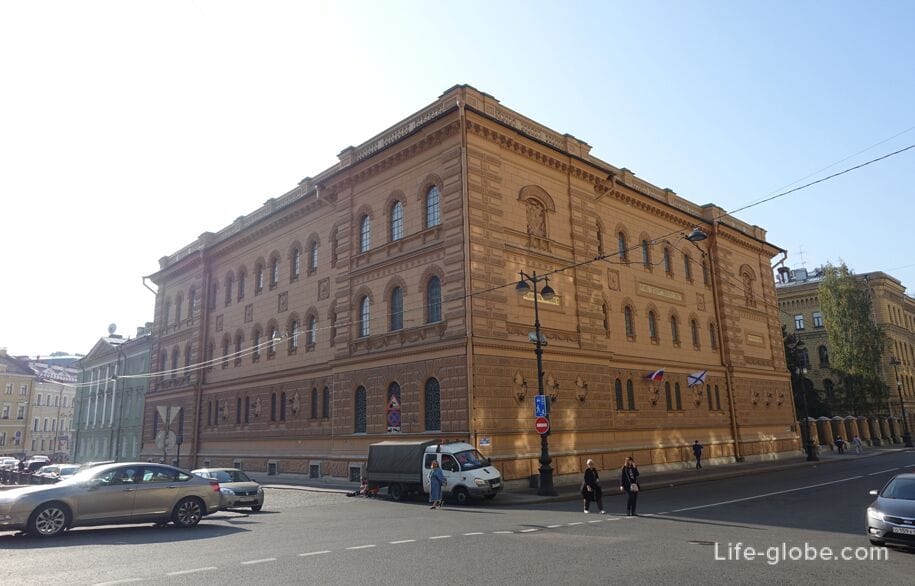
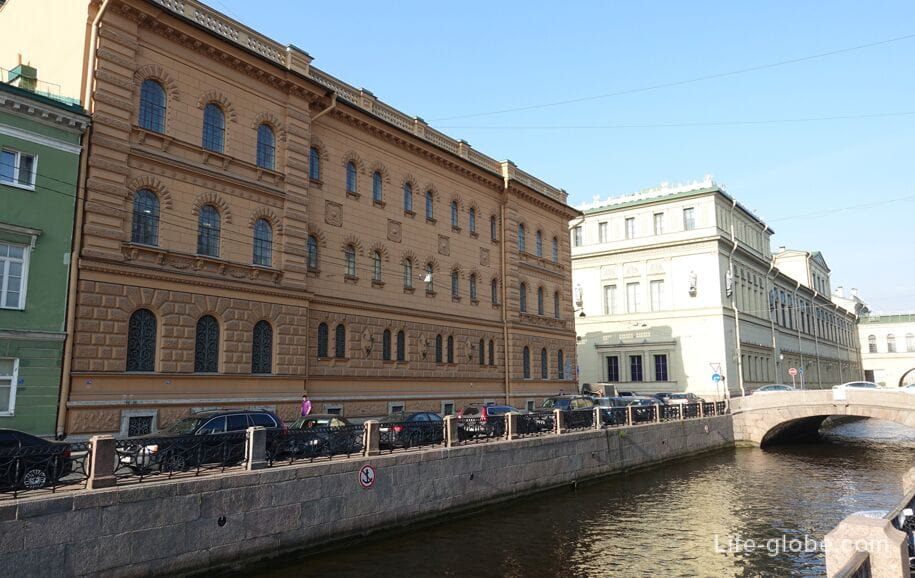
The building of the archive of the Navy is adjacent to the house of A. A. Arakcheev, which is a corner building facing the embankment of the Winter Canal and the embankment of the Moika River.
This house was built on the site where, until the end of the 18th century, there were backyards facing Palace Square of residential buildings. In July 1797, the demolition of buildings began, and on this site, according to the project of architect F.I. Demertsov, a mansion was erected for Count Alexei Andreevich Arakcheev.
In 1800, Arakcheev sold the mansion to the merchant A. K. Zhukov. In 1835, the building was purchased by the wife of the captain of the 2nd rank Bogdanovich, for whom some internal reconstruction of the building was made, and who rented out the premises in the house to the officers of the second battalion of the Life Guards of the Preobrazhensky Regiment. After about 20 years, the mansion was acquired by the command of the Preobrazhensky Regiment.
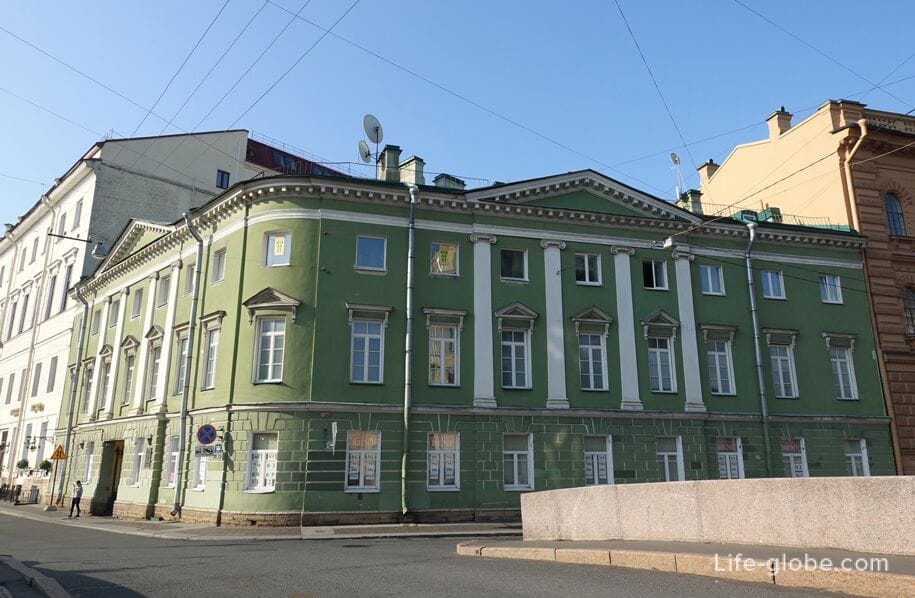
In the alignment of the Moika River embankment, the 2nd Winter Bridge is thrown over the Winter Groove, which is a single-span reinforced concrete arch structure, the span of which is made in the form of a hinged arch. Abutments made of monolithic reinforced concrete on a pile foundation. The arch and abutments are faced with granite. The rustication of the arch with a keystone repeats the outline of the arch of the 1st Winter Bridge. The railing, as on the 1st Winter Bridge, is a solid granite parapet.
The roadway and sidewalks of the bridge are covered with asphalt concrete.
The bridge in this place was thrown in 1933, in order to pass the columns after the festive demonstrations on May 1 and November 7.
In 1940, a permanent wooden single-span bridge was built on the site of the floating crossing. The bridge was named the 2nd Winter Bridge because it is located downstream from the Winter Bridge; at the same time, the Winter Bridge became the 1st Winter Bridge.
The modern 2nd Winter Bridge was built in 1962-1964 by engineer V. S. Ksenofontov and architect L. A. Noskov.
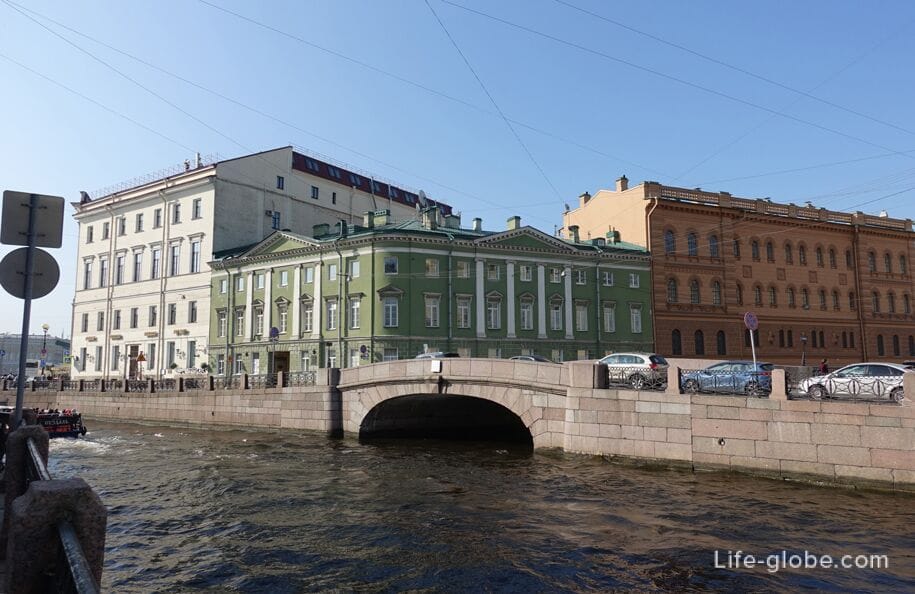
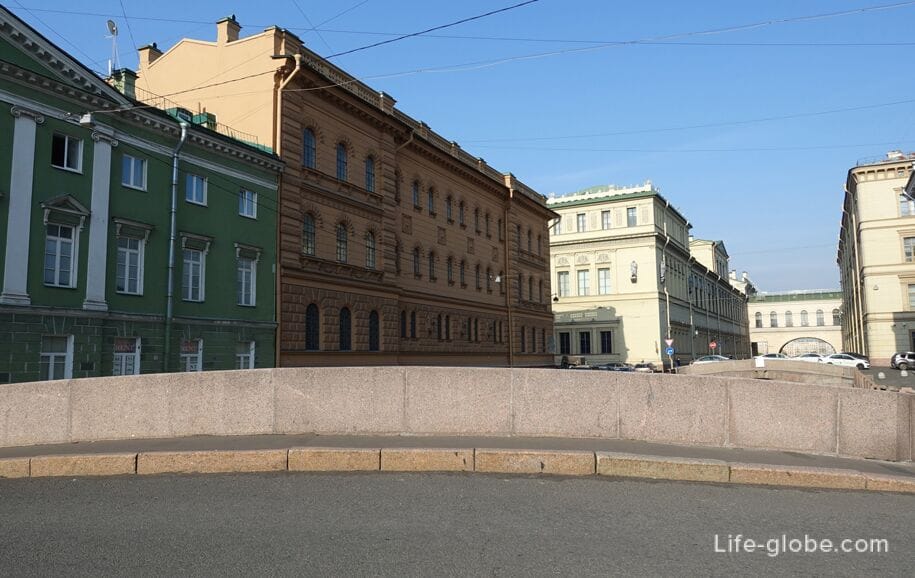
View of the Moika River Embankment and the 2nd Winter Bridge (on the right)
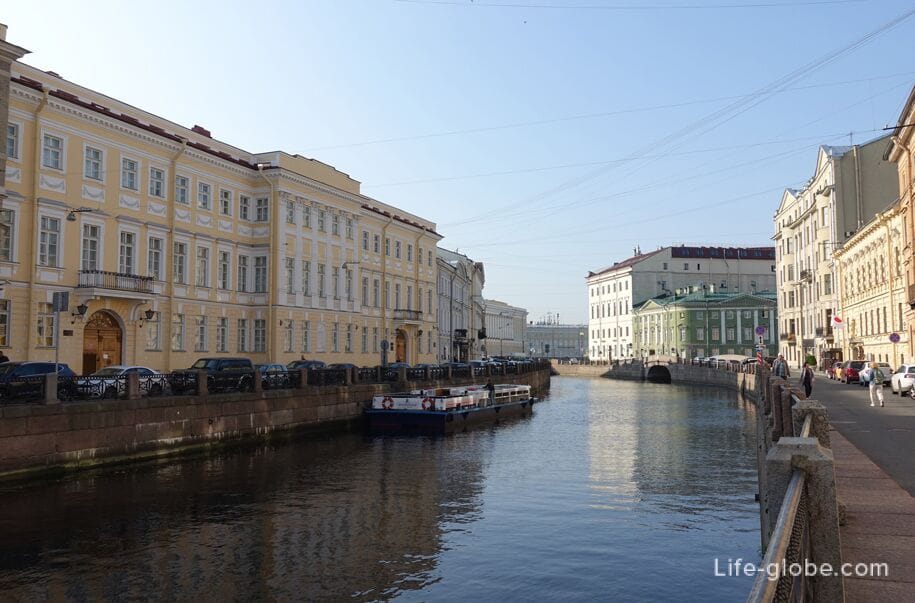
On the East side of the 2nd Winter bridge on the embankment of the Winter canal and the Moika river is located the corner of the building - the apartment house of Fersen, who is more popularly known as the home of Sobchak (boyar), since in one of the apartments of the house, the first and only mayor of St. Petersburg has lived for many years in the 2000-th year.

Winter Groove is located in the heart of St. Petersburg, close to such famous attractions as the Winter Palace (Hermitage), Saved on Blood, St. Isaac's Cathedral, Palace Bridge, Admiralty building, etc.
Nearest metro stations: "Admiralteiskaya", "Nevsky Prospekt" and "Gostiny Dvor".
All accommodation facilities in St. Petersburg, including in the city center and near the Winter Canal, can be viewed and booked here